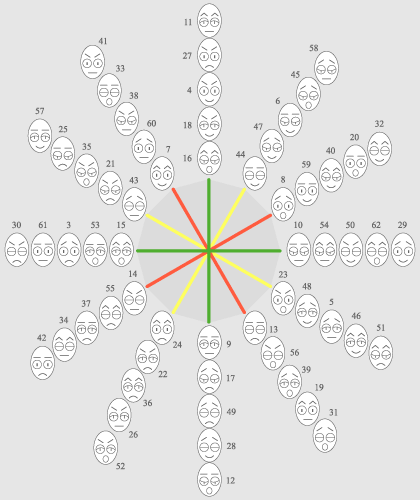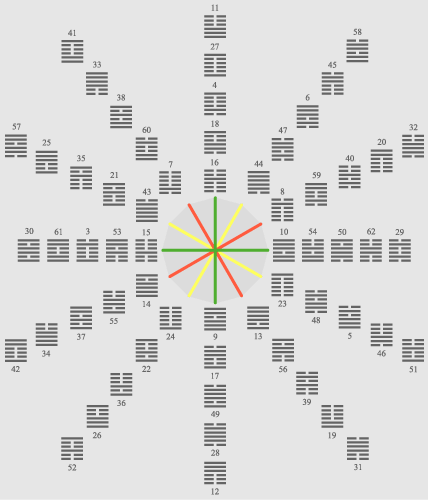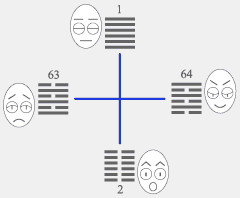-
Hexagrams of the canon of changes i-jing and physiognomic symbols allow to
systematize human emotions, and also allow to identify emotional displays of
people, namely allow to compare emotions of people to physiognomic symbols and
to identify emotional types and images which are shown in faces of people, that
allows to speak about harmonious or disharmonious parities of emotional
displays. Namely if emotional types and images are known then it is possible to
speak about harmonious or disharmonious mutual relations of people.
Parities of emotional displays, and in essence parities of human mutual
relations caused by emotional types and images, it is possible to analyze by
means of the circular scheme, and in particular by means of two shown schemes.


-
Physiognomic symbols and hexagrams i-jing in the shown schemes form 12
pentads which correspond with 12 parts of the circle. In each pentad there are 5
physiognomic symbols and 5 hexagrams i-jing.
According to angular ratio or otherwise to tell aspects of 12 pentads it is
possible to speak about harmonious or disharmonious parities of emotional
displays, that is specified by crosses of different colors within the circle.
If physiognomic symbols are in one pentad or within one cross of any one color
then have disharmonious parities of emotional displays, and parities are
harmonious in all other cases. Namely if physiognomic symbols are connected with
a cross of any one color then parities of emotions and mutual relations of
people are disharmonious. And if physiognomic symbols are connected with crosses
of different colors then parities of emotional displays and mutual relations of
people possess harmony.
For example, within the red cross there is a disharmony in emotions of 7th and
42nd physiognomic symbols, or within the green cross there is a disharmony in
emotions of 61st and 62nd physiognomic symbols.
Or within the red and green crosses there is a harmony in emotions of 7th and
61st physiognomic symbols.
It is necessary to consider that 60 hexagrams i-jing and 60 physiognomic symbols
are involved in the shown scheme, as 12 pentads have 12x5=60 symbols, and 4
hexagrams form the special cross in which physiognomic symbols have harmonious
parities with any other physiognomic symbols, that is shown on the following
scheme.
 |
As it is possible to see: 1st hexagram corresponds with physiognomic symbol in which emotions of all facial elements are quiet; 2nd hexagram corresponds with physiognomic symbol in which emotions of all facial elements are open; 63rd hexagram corresponds with physiognomic symbol in which emotions of all facial elements are sad; 64th hexagram corresponds with physiognomic symbol in which emotions of all facial elements are joyful. These physiognomic symbols have harmonious parities of emotions with any other symbols and are beyond the general scheme of others. |
More detailed information on principles according to which hexagrams of
the canon of changes i-jing and physiognomic symbols are located in
circular schemes, look on pages of this
website in other section which has the name circles of
emotions.
If the analysis of parities of emotional displays according to three crosses
within 12 parts in the circular scheme of physiognomic symbols is insufficient
then it is possible to consider angular parities in more detail by analogy to
aspects in astrology.
Aspect of 0 degrees.
To this aspect there corresponds position of physiognomic symbols within one
pentad.
For example, to this aspect there correspond positions of 42nd and 14th
physiognomic symbols.
In this case mutual relations of people are disharmonious as each subject of
dialogue subordinates emotional displays of the opponent to own emotions. Or
mutual relations of people can be counterbalanced if emotions of one person are
subordinated to emotions of the second person as a result of dialogue, namely if
emotions of subjects in dialogue are identical and correspond to one
physiognomic symbol.
Aspect of 30 degrees.
For example, to this aspect there correspond positions of 14th and 15th
physiognomic symbols.
In this case mutual relations of people are harmonious, but it seems that people
show indifference concerning to each other, namely emotional displays of
subjects in dialogue seem indifferent.
Aspect of 150 degrees.
For example, to this aspect there correspond positions of 15th and 59th
physiognomic symbols.
In this case mutual relations of people are harmonious, but it seems that
emotional displays of people are inadequate, namely it seems that emotions of
subjects in dialogue are not coordinated.
Aspect of 60 degrees.
For example, to this aspect there correspond positions of 59th and 18th
physiognomic symbols.
In this case mutual relations of people are harmonious and coordinated, namely
there is an impression that each subject of dialogue coordinate own emotions
with emotions of the opponent.
Aspect of 120 degrees.
For example, to this aspect there correspond positions of 18th and 51st
physiognomic symbols.
In this case mutual relations of people are the most harmonious in comparison
with other aspects, namely it seems that people possess the perfect mutual
understanding.
Aspect of 90 degrees.
For example, to this aspect there correspond positions of 51st and 6th
physiognomic symbols.
In this case mutual relations of people are disharmonious and disputed, namely
it seems that emotional displays of people are caused by antagonism.
Aspect of 180 degrees.
For example, to this aspect there correspond positions of 6th and 52nd
physiognomic symbols.
In this case mutual relations of people are disharmonious and inconsistent,
namely it seems that people do not understand each other.
According to the listed values of aspects it is possible to analyze angular parities of emotional types and images within the circular scheme, and it is possible to analyze mutual relations of people.
The following page results the information on psychological characteristics of emotional types.
-